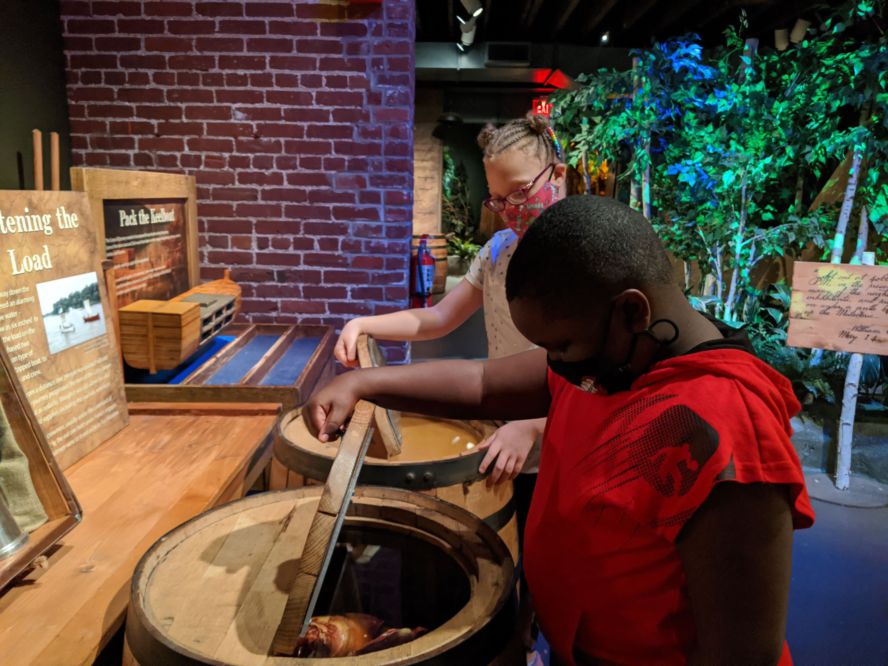
Campers in the Frazier History Museum’s NTI program examine artifacts in the museum’s Lewis and Clark exhibit.
By Laura Casey, Texas Historical Commissions and AASLH’s Field Services Alliance
Museums and historic sites spent most of 2020 adapting to the challenges presented by COVID-19. As some areas of the country enter another period of shutdowns, it is important for museums to connect with their community and provide whatever assistance is possible. That assistance can demonstrate how relevant and critical the museum is to the fabric of the local community.
Below are ten unique ways museums can offer assistance and support to their community during this time of crisis. Taking an active approach can lead to new opportunities for collaboration, partnership, and sustainability once life and work return to more normal conditions. Any of these ideas can be adapted in scope and size to work for your organization.
- Lend assistance to the local food pantry. The Brooklyn Museum used its back parking lot as a temporary food distribution location. The Filson Historical Society serves as a drop off location for Feed the West, a food donation/distribution initiative led by the non-profit Change Today, Change Tomorrow, in Louisville, Kentucky. If your organization doesn’t have a large parking lot or square footage to spare you might consider letting employees spend some work time helping at a local food pantry, Meals on Wheels or other local service organization lending support. Encouraging museum volunteers to spend some of the time normally spent at the museum at another community organization is also a way to give back to the community.
- Personal Protective Gear (PPE) is once again in short supply. Many museums are lending technology to help solve this problem. Other museums like KidZone Museum in Truckee, CA are sewing fabric masks with That’s Sew Tahoe. Giving staff and volunteers an opportunity to make fabric masks for essential workers or museum visitors is a worthwhile investment. It can be done at the museum or at home and is a great way to contribute.
- Technology is a resource museums can share. Several science museums across the country, like the Museum of Science and Industry in Chicago, are lending their 3-D printers to help make Personal Protective Equipment. The 3-D printers can make face shield frames, plastic mask frames, ear savers, plastic clips, and other essential tools for health care workers and others providing essential services.
- Contact the American Red Cross or a local organization to host a blood and plasma donation drive. Whole blood and plasma are in especially high need at the moment. If your site is large enough, consider hosting the blood drive. If not, approach another organization as a way to partner. Encouraging staff and volunteers to take some time during the day to donate is another great way to show support. If you are not able to give blood, use the time to work a shift at the blood drive. Offering incentives is also a way to drive participation in a local blood drive. Talk to the local blood bank and other organizations and see what unique ideas will work for your area.
- Studies show that art and music help heal the body and soul as well as adding beauty to its surroundings. Perhaps your museum can help bring art, music, history or science to a public area. Crystal Bridges in Bentonville, Arkansas, brought artwork to outdoor areas of hospitals and senior living facilities to help combat loneliness with the Social Connecting Campaign. The museum commissioned original work from nine local artists and also developed postcards that were sent to over 3,600 people in hospitals, senior living facilities, and other isolated populations.

“Feed the West” grocery list at the Filson Historical Society
- Does your organization have access to a parking lot? If so, consider being a COVID testing site. There may be ways to get museum staff safely involved on testing days as well. People are always needed to direct traffic, bring essentials to the testing staff, or run messages back and forth.
- Some museums are hosting learning pods. To assist overwhelmed parents and school systems, museums saw an opportunity to host groups of ten students who work in “pods” at the museum. Educators at the museum provide assistance to the children while they attend class virtually through their regular school. The museum provides break-time and, in some cases, after-school activities. This is an opportunity for small, medium, and large museums to work together. Smaller museums may not have the space to host a learning pod but can lend their staff to help an existing program at a larger museum expand the number of pods they host. A program like this opens new avenues of sponsorship. Is there a local donor who will cover the costs for low-income students to attend? The Little Scholars Program at Fort Worth Museum of Science and History and NTI at the Frazier Museum in Louisville, KY are two examples.
- Partner with local businesses and organizations around town that are willing to host pop-up exhibits. Pop-up banners are a convenient and reasonably priced way to repurpose existing exhibit content or create new content. These banners are easy to transport, install, and display which provide maximum flexibility in exhibiting. Banners work well in small areas and also for windows that can be viewed from outdoors or even a car. During the pandemic, consider placing the exhibits in essential businesses and always look for businesses and organizations that are willing to be sponsors. Examples of pop-up banner exhibits, research resources, and exhibit text can be found here under the Traveling Exhibit tab.
- The pandemic is shifting how people think about going to public places and how they interact in that space once there. Museums and historic sites can play a role in addressing trauma and post-traumatic stress disorder that will arise as the pandemic begins to subside and eventually fade. Art museum educators started the Trauma-Aware Art Museum Educators Group to begin discussing these issues. It’s also a relevant topic for history museums to consider.
- Looking toward spring, if land and space are your resource, consider planting a garden. Fresh produce is always a need and you can partner with a local food bank or other group to distribute the produce. This is a great way to utilize existing and new volunteers. Old Salem Museums and Gardens in North Carolina turned their gardens into Victory Gardens reminiscent of those in World War II.
What is the Field Services Alliance? The Field Services Alliance (FSA) is an organized group of individuals, offices, and agencies that provide training opportunities, guidance, technical services, and other forms of assistance to local historical societies, archives, libraries, and museums in their respective states or regions. Click here to learn more.



